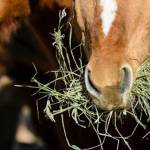Forage Preference: What Kind Does Your Horse Like?

Almost everyone knows the phrase “hay is for horses,” but did you ever stop to think that maybe your horse enjoys some forage more than others? Does your gelding prefer timothy hay to fescue pasture; does your aged mare plunge eye-deep into alfalfa (lucerne) but turns up her nose at lespedeza? Scientists have uncovered forage preferences among horses.
Previous studies on this topic revealed that horses preferred Kentucky bluegrass, timothy, and fescue. Their least favorites were meadow foxtail, meadow bromegrass, creeping foxtail, orchardgrass, and reed canarygass when planted alone.
According to the Minnesota researchers, cool-season grasses predominate in pastures in the Midwest and eastern United States. Examples include orchardgrass, creeping foxtail, smooth and meadow bromegrass, timothy, tall fescue, and ryegrass. Pastures are frequently a mixture rather than monocultures because mixed fields often afford higher yields, are better adapted to harsher environments, suppress weeds, have nutritional benefits, and forage persistence.
Despite the reported benefits of certain mixtures of grasses, grazing horses can thwart even the best-laid plans. To better understand horse preference and the impact of grazing, Martinson and colleagues planted eight different commercially available cool-season grass mixtures in various combinations. They subsequently measured the density of each grass and grazing preference for three years.
Horses preferred mixtures containing tall fescue, perennial ryegrass, Kentucky bluegrass, and timothy. Fields containing more than 30% orchardgrass were least preferred. Unfortunately, the research team also noted that within two years, the amount of orchardgrass and tall fescue increased in the fields and that orchardgrass became the dominant species in fields sown with it regardless of the initial percentage in the mixture.
“The study authors therefore recommended that Midwest pastures should be planted with a combination of tall fescue, perennial ryegrass, Kentucky bluegrass, and timothy but that the pastures would likely transition to tall fescue and Kentucky bluegrass under grazing,” explained Kathleen Crandell, Ph.D., a Kentucky Equine Research (KER) nutritionist. “This means that overseeding with the diminishing grass species may be necessary to keep diversity in the pastures.”
Tall fescue is safe for most horses except mares in the third trimester of pregnancy. Certified endophyte-free tall fescue is safe for all horses, including pregnant mares, but there are other sources of infested fescue. It’s also important to watch for various weeds of worry in your pastures.
*Martinson, K.L., M.S. Wells, and C.C. Shaeffer. Horse preference, forage yield, and species persistence of twelve perennial cool-season grass mixtures under horse grazing. Journal of Equine Veterinary Science. In press.








